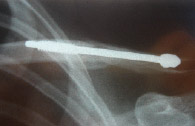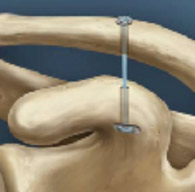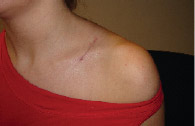This article by a shoulder expert explains the modern methods behind shoulder surgery and will be helpful for anyone who, through leading an active lifestyle, has suffered a shoulder injury.
Contents
Introduction
Be more active, do more exercise, take up a sport or go to the gym. And if you follow that advice it may work wonders in improving respiratory capacity and cardiac function. But big lungs and a strong heart sometimes come at the expense of a significant shoulder injury. Obviously some sports are more dangerous than others and clearly impact sports or collision sports as our American cousins call them, carry a higher risk than lawn bowls.
In this article I want to explain the ‘state-of-the-art’ options available to treat three of the most common shoulder injuries giving you all the information you need should you fall off a horse, go over the handle-bars or get up-ended and dumped unceremoniously in a rugby match and need surgery!
In the last few years the treatment of shoulder injuries has changed for the better and we now know that significant improvement in outcomes can be achieved with surgery as opposed to the traditional method of ‘supervised neglect’ in an old-fashioned sling.
One of the common injuries is the clavicle fracture that occurs with simple falls and which I see most frequently in riders and polo-players. The traditional teaching is that, as long as you and your arm are in the same room, virtually all will heal uneventfully and with no long term problems so you don’t need surgery. As a shoulder surgeon I see a rather different picture and recent research proves that up to 30% of one particular type of break actually will not heal and should be operated on. This group are usually high-energy injuries where the ends of the bones are completely off-ended, overlapped by more than 1 cm and with one end tenting the skin.
Surgery is the best option

The best result from this type of injury is achieved with surgery. Generally this would be done with a plate and screws but I would now recommend using a pin (Rockwood Clavicular Pin - DePuy) that screws into the intermedullary canal of the bone. This ‘kebabs’ the broken bone by holding it at the right length and compressing the ends together to encourage healing.
The benefits of this are that it can be done through a much smaller incision (3 cms rather than 12 cms) which is of particular importance for women whose collar bones tend to be on display more than men’s. Other issues are that the plate is prominent and can cause discomfort with bags carried over the shoulder so that it needs to be removed causing temporary bone weakness and further scar problems. The pin also needs to be removed but this is done through a small incision in the back of the shoulder.
If you play collision sports such as rugby or participate in winter sports, then you run the risk of a dislocated shoulder and, as with many aspects of shoulder surgery, the treatment for this has moved on. It has long been taught that 80% of dislocations are one off events so surgery is not indicated. The risk of a re-dislocation is actually linked to age and activity such that in the sporty, under 30 year old the chance of a recurrence is over 80%. In this group I would recommend that the shoulder is stabilised surgically as quickly as possible after the injury.
Bankart stabilisation
The shoulder is rather like a golf ball on a golf tee. The socket has a lip of gristle (to use a technical term!) called the labrum surrounding it that turns it from a saucer into a shallow bowl. In a dislocation the ball shoots forwards off the socket tearing off the labrum. Once the ball is put back into place the labrum may or may not flip back into the correct position and may or may not reattach there. In the early stages, the body is doing its best to heal up and a helping hand from the surgeon to line up the labrum and reattach it to the socket will maximise the chance of everything joining up in the right place. The operation - a Bankart repair or stabilisation - is done using an arthroscopic technique using only two or three very small incisions and less postoperative pain. With this procedure the aim is to recover a full range of motion and the return of normal function.
Another common shoulder injury is to disrupt the acromio-clavicular joint (ACJ) which is the lumpy part at the end of the collar-bone where it joins the shoulderblade. The usual cause for this is a fall onto the point of the shoulder and I see this most frequently in mountain bikers. Depending on the angle and force of that fall, the ACJ can either be sprained or the two elements can be torn apart. In the latter situation the patient will feel an obvious step on the point of the shoulder - and a lot of pain.

As with collar bone fractures, shoulder surgeons are more prepared to operate on these injuries because we have to cope with all the problems that occur if they are left! And we now have a new, and better operation, to deal with acute ACJ disruptions. In this injury the main ligaments that hold the collar-bone down onto the shoulder blade have been ruptured but, if they can be brought back into contact, then they should heal. To do this we pass what is effectively a mini block and tackle (Tightrope - Arthrex) through holes drilled in the two bones, and then tighten it up so pulling the bones, and therefore the ligament ends, back together. This is also done arthroscopically so the scarring is minimal. The patient is placed in a sling for 4 weeks before starting rehabilitation aiming for a fully functional, fully moving and strong shoulder by 3 months. This technique can only be offered in the acute stage ie. the first 2 - 3 weeks after the accident as after that time the ligament ends will have scarred up and will not heal even when brought together.
The shoulder is a complex joint peforming the role of positioning the hands in space around the body so that they can carry out all their functions. When it is working properly we do not give it a second’s thought but when it is injured it does not take long to realise how incapacitating a damaged shoulder can be. Research has shown that what have long been considered fairly benign injuries actually do not do as well as was thought and that, in selected cases, the surgical answer is the better option. The principles of the operations I have described are to give nature a helping hand in the early stages when the body is desperately trying to heal. Rather than replacing parts through big incisions or using materials that stay in the body for ever, we have moved to minimally invasive, arthroscopic techniques using bio-absorbable materials that hold the damaged parts together while they heal up.
Surgery should be discussed

The advent of these novel operative techniques and implants taken in conjunction with the realisation that these injuries do not always do well treated conservatively, has resulted in a sea-change in the management of shoulder trauma. The operations I have discussed are the ones I favour and I have tried to explain the rationale behind my choice of procedure. Other surgeons will have their preferred techniques but the important thing is to be aware that surgery is an option and should be discussed.
So, if you are unfortunate enough to fracture a collar-bone, dislocate a shoulder or disrupt the ACJ as a result of sporting prowess then you should be fully informed of the options available in order to maximise the chance of recovering a normal shoulder. With all that is available it is no longer acceptable to be told simply not to worry and that everything will be fine with a sling and a long wait!





